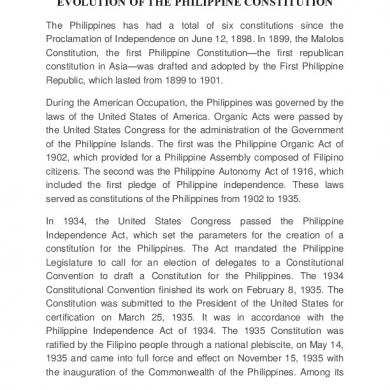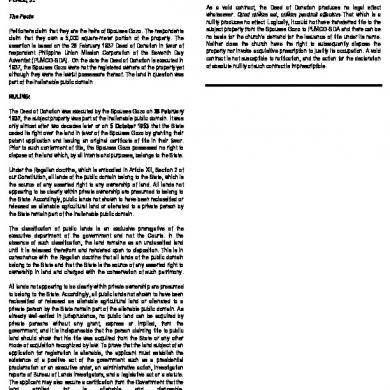9.9 Cd_heirs Of Gozo Vs Philippine Union Mission Corp Of The 7th Day Adventist Church
This document was uploaded by user and they confirmed that they have the permission to share it. If you are author or own the copyright of this book, please report to us by using this DMCA report form. Report DMCA
Overview
Download & View 9.9 Cd_heirs Of Gozo Vs Philippine Union Mission Corp Of The 7th Day Adventist Church as PDF for free.
More details
- Words: 795
- Pages: 1
Loading documents preview...
HEIRS OF RAFAEL GOZO REPRESENTED BY CASTILLO GOZO AND RAFAEL GOZO, JR. v. PHILIPPINE UNION MISSION CORPORATION OF THE SEVENTH DAY ADVENTIST CHURCH (PUMCO), SOUTH PHILIPPINE UNION MISSION OF SDA (SPUMCO) AND SEVENTH DAY ADVENTIST CHURCH AT SIMPAK, LALA, LANAO DEL NORTE REPRESENTED BY BETTY PEREZ; G.R. No. 195990, August 05, 2015; PEREZ, J.: The Facts Petitioners claim that they are the heirs of Spouses Gozo. The respondents claim that they own a 5,000 square-meter portion of the property. The assertion is based on the 28 February 1937 Deed of Donation in favor of respondent Philippine Union Mission Corporation of the Seventh Day Adventist (PUMCO-SDA). On the date the Deed of Donation is executed in 1937, the Spouses Gozo were not the registered owners of the property yet although they were the lawful possessors thereof. The land in question was part of the inalienable public domain RULING: The Deed of Donation was executed by the Spouses Gozo on 28 February 1937, the subject property was part of the inalienable public domain. It was only almost after two decades later or on 5 October 1953 that the State ceded its right over the land in favor of the Spouses Gozo by granting their patent application and issuing an original certificate of title in their favor. Prior to such conferment of title, the Spouses Gozo possessed no right to dispose of the land which, by all intents and purposes, belongs to the State. Under the Regalian doctrine, which is embodied in Article XII, Section 2 of our Constitution, all lands of the public domain belong to the State, which is the source of any asserted right to any ownership of land. All lands not appearing to be clearly within private ownership are presumed to belong to the State. Accordingly, public lands not shown to have been reclassified or released as alienable agricultural land or alienated to a private person by the State remain part of the inalienable public domain. The classification of public lands is an exclusive prerogative of the executive department of the government and not the Courts. In the absence of such classification, the land remains as an unclassified land until it is released therefrom and rendered open to disposition. This is in consonance with the Regalian doctrine that all lands of the public domain belong to the State and that the State is the source of any asserted right to ownership in land and charged with the conservation of such patrimony. All lands not appearing to be clearly within private ownership are presumed to belong to the State. Accordingly, all public lands not shown to have been reclassified or released as alienable agricultural land or alienated to a private person by the State remain part of the alienable public domain. As already well-settled in jurisprudence, no public land can be acquired by private persons without any grant, express or implied, from the government; and it is indispensable that the person claiming title to public land should show that his title was acquired from the State or any other mode of acquisition recognized by law. To prove that the land subject of an application for registration is alienable, the applicant must establish the existence of a positive act of the government such as a presidential proclamation or an executive order, an administrative action, investigation reports of Bureau of Lands investigators, and a legislative act or a statute. The applicant may also secure a certification from the Government that the land applied for is alienable and disposable.
It is beyond question that at the time the gratuitous transfer was effected by the Spouses Gozo on 28 February 1937, the subject property was part of
the public domain and is outside the commerce of man. It was only on 5 October 1953 that the ownership of the property was vested by the State to the Spouses Gozo by virtue of its issuance of the OCT pursuant to the Homestead Patent granted by the President of the Philippines on 22 August 1953. Hence, the donation of the subject property which took place before 5 October 1953 is null and void from the very start. As a void contract, the Deed of Donation produces no legal effect whatsoever. Quod nullum est, nullum producit effectum. That which is a nullity produces no effect Logically, it could not have transferred title to the subject property from the Spouses Gozo to PUMCO-SDA and there can be no basis for the church's demand for the issuance of title under its name. Neither does the church have the right to subsequently dispose the property nor invoke acquisitive prescription to justify its occupation. A void contract is not susceptible to ratification, and the action for the declaration of absolute nullity of such contract is imprescriptible.
It is beyond question that at the time the gratuitous transfer was effected by the Spouses Gozo on 28 February 1937, the subject property was part of
the public domain and is outside the commerce of man. It was only on 5 October 1953 that the ownership of the property was vested by the State to the Spouses Gozo by virtue of its issuance of the OCT pursuant to the Homestead Patent granted by the President of the Philippines on 22 August 1953. Hence, the donation of the subject property which took place before 5 October 1953 is null and void from the very start. As a void contract, the Deed of Donation produces no legal effect whatsoever. Quod nullum est, nullum producit effectum. That which is a nullity produces no effect Logically, it could not have transferred title to the subject property from the Spouses Gozo to PUMCO-SDA and there can be no basis for the church's demand for the issuance of title under its name. Neither does the church have the right to subsequently dispose the property nor invoke acquisitive prescription to justify its occupation. A void contract is not susceptible to ratification, and the action for the declaration of absolute nullity of such contract is imprescriptible.
Related Documents

Philcom Employees Union Vs Philippine Global Comm
February 2021 1
Vigilla Vs Philippine College Of Criminology Inc
February 2021 0
Evolution Of The Philippine Constitution
February 2021 0
The Making Of The Union Flag
February 2021 0
Evangelical Dictionary Of World Mission
February 2021 10More Documents from "Alexander Pluas"

Leonen Cases
February 2021 0
Mouth To Mouth By Christian Simamora.pdf
February 2021 0
Math
January 2021 4
Tugas 1 Mk An-survival
January 2021 0
